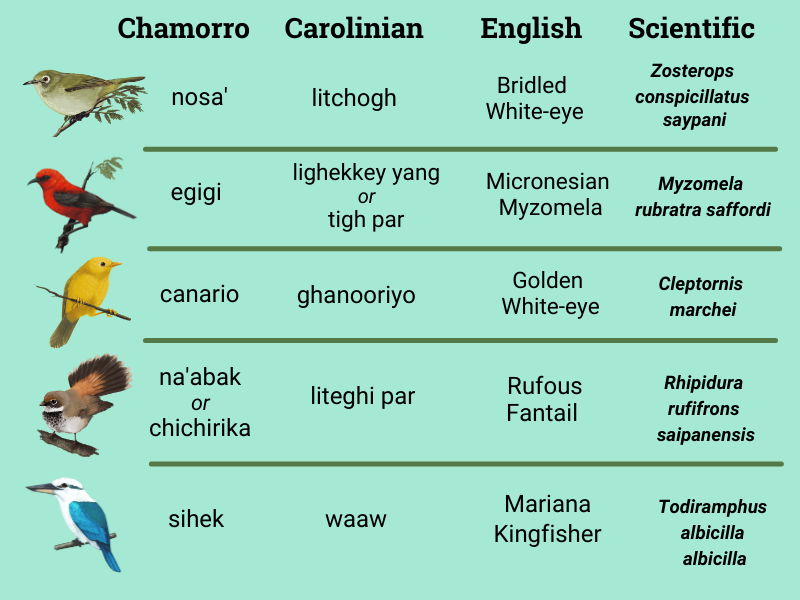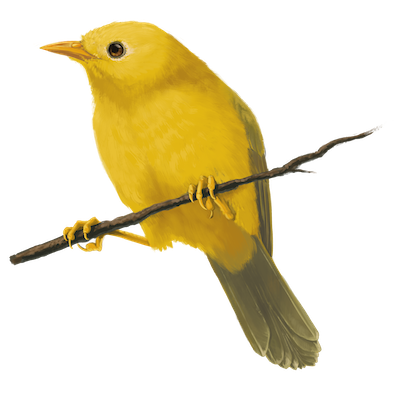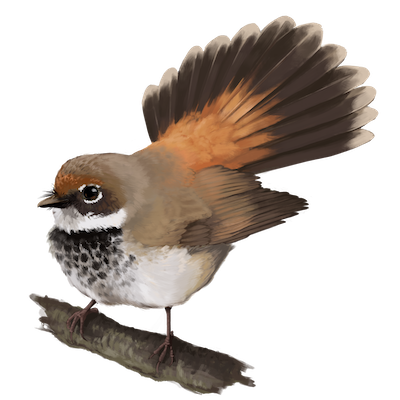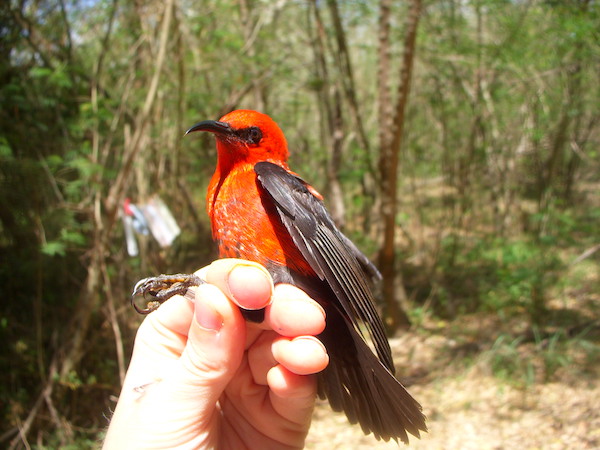A recent study in the journal Pacific Science by IBP scientists Jim Saracco and Lauren Helton, along with colleagues from the Division of Fish and Wildlife, Commonwealth of the Northern Mariana Islands, looks at trends in landbird populations on the island of Saipan in the western Pacific. The researchers focused on five endemic bird species and found that all but one declined during the 11 year study period (2008-2018).
Saipan is also home to two indigenous peoples: the Chamorro and the Carolinians. People on Saipan refer to the species in this study by their Chamorro and Carolinian names. Those names are given in the table below.

Illustrations by Lauren Helton
Of these five species, only the Golden White-eye did not show population declines. The study found that many of these species can have wide variations in survival over the short term, so it's possible that Mariana Kingfisher, Micronesian Myzomela, and Bridled White-eye will all show increases over the next few years, or they might continue to decline. Unfortunately, the Rufous Fantail decline trend looks more like a slow but steady trend downward. We spoke with Lauren Helton about the study and what might be causing population declines in Saipan's birds.
What are the biggest threats to endemic landbirds on Saipan?
Habitat loss and degradation is the greatest threat. The island is seeing rapid development and increases in human activity everywhere. Clearing for building and farming is one huge problem, but habitat can also be lost through damage by storms - especially the super-typhoons the island has seen lately (for example Soudelor and Yutu), which are themselves probably linked to climate change and are expected to become more frequent and more severe in the future.
Saipan's forests are somewhat resilient to typhoons, but when the storms hit harder and more frequently, it gives the forest less time to regenerate. The resulting patches of downed trees are more likely to be colonized by fast-growing and generally small nonnative plant species (such as tangantangan, Leucaena leucocephala) or become replaced with grasses and shrubs. Luckily Saipan's birds so far have shown an ability to make use of these habitats. However, we don't know if that will remain true long-term, especially if we see increasing loss over time of native rainforest habitat from both human activity and storms.

Mariana Kingfisher. Illustration by Lauren Helton.
Climate change may also result in extended droughts, which can lead to larger, more severe wildfires. There have been a few small wildfires on Saipan in recent years and it's concerning to think that a wet tropical island could start to dry out and see a lot more of those, which would further degrade remaining habitats.
And of course there's the ever-present threat of brown tree snakes, which wiped out most native birds on the neighboring island of Guam. This species could arrive and become established on Saipan at any time if enough stow away in shipments and aren't caught by extra-vigilant observers. Individual snakes do sometimes make it to Saipan and I've heard it said that many think the snake is a "not if, but when" scenario. There are no native snakes on Saipan and the birds there are highly susceptible to a novel predator like this one.
Why do you think that Golden White-eye populations are not showing a population decline, like the other species?
We're incredibly lucky that Golden White-eyes appear to be holding up. They seem to be generalists when it comes to diet, which is in their favor. Think of a Golden White-eye as a thrush-like species - they'll eat insects, fruit, and seeds out of trees but also off the ground by kicking up leaf litter and debris to find food like seeds and invertebrates underneath.

Golden White-eye. Illustration by Lauren Helton.
When a big storm hits, it strips leaves, fruit, and flowers off the trees. Losing leaves means you lose insects that live and eat off those leaves, which are the bulk of the Rufous Fantail diet. Losing flowers is hard for the myzomelas, which consume a lot of nectar. But fruit and seeds can sit on the forest floor and potentially still be accessible to generalists like the Golden White-eyes (and Bridled, but their smaller beaks might mean they're more limited in what they can eat). We haven't measured this, but I'd guess that all that debris after a storm might mean there are increases in invertebrates that eat that debris, and Golden White-eyes probably eat those invertebrates too. Now this doesn't mean the Golden White-eyes purely benefit from storms because the high winds and rain can injure and kill the birds and can also destroy their nests, chicks, and eggs - but the survivors might be better at recovering afterward.
In order to calculate the measures of population health used in this study, such as survival and productivity, you need to determine the birds' ages. Can you talk about the challenges or differences in ageing tropical birds?
The biggest difference, for those who are used to ageing temperate birds with a distinct once-a-year breeding season, is that these birds have two main nesting periods per year and sometimes just breed at other times of the year anyway. This means the familiar ageing scheme of hatching year, second year, after hatching year and so on, based on a calendar system that starts January 1, is pretty much useless since on any date you could capture birds in every age range and in a variety of molt cycles.

Rufous Fantail. Illustration by Lauren Helton.
Plus, since these birds don't really migrate and have fewer seasonal pressures related to things like temperature and food availability, they're sometimes in no rush to hurry up and molt so they can be done with it. The Micronesian Myzomela, for example, will often drag out its molt over several months, just slowly replacing feathers one or two at a time. So instead of a molt limit–where there's a clear and distinct difference in worn, older feathers versus fresh newly-replaced feathers–you get what we call a "molt cline" where all the feathers are the same generation but the ones replaced first look old and worn and then they slowly get fresher as you go through that feather tract.
And, for a bonus bit of confusion, in the temperate zones if you see breeding characteristics on a bird it's safe to assume the bird didn't hatch that year, because typically they hatch in spring and aren't ready to breed until the following spring. But in the tropics, a bird can hatch in January or February and start showing breeding characteristics like a brood patch in late fall or early winter when it's around 10 months old - still a hatch-year bird, but functionally an adult.
Because of all this, in the tropics we strongly encourage the use of the WRP ageing system. Rather than trying to decide if the bird was born in a specific calendar year or not, we record the plumage characteristics. Is the bird in juvenile plumage? Formative? Is it in formative plumage but undergoing its first prebasic molt and replacing all those feathers with new adult feathers? It gives us a way to assign a bird to a specific plumage which corresponds to a specific life stage without worrying about dates, and in the tropics that feels a lot more biologically meaningful.
In your opinion, what is the take home message of this study and IBP's work on Saipan so far?

Bridled White-eye. Illustration by Lauren Helton.
For the most part, the birds of Saipan are still holding on despite the challenges they face, but they're perched on a bit of a knife's edge. Push them too hard with habitat loss and climate change and the resilience they've shown so far might finally fail. I really hope the Rufous Fantail's downward trend is still reversible, and that the other species' declines are temporary, but the only way to know for sure is to keep monitoring them and doing everything we can to protect the remaining habitat. Climate change is going to remain a huge problem going forward but its effects on the island's birds might be mitigated somewhat if Saipan's forests can be maintained and restored through things like tree planting and invasive vine removal. And of course close inspection of cargo for incoming snakes must continue. If we do nothing, then we'll be blind to when these bird species tip over the edge and decline in a way that's irreversible.






